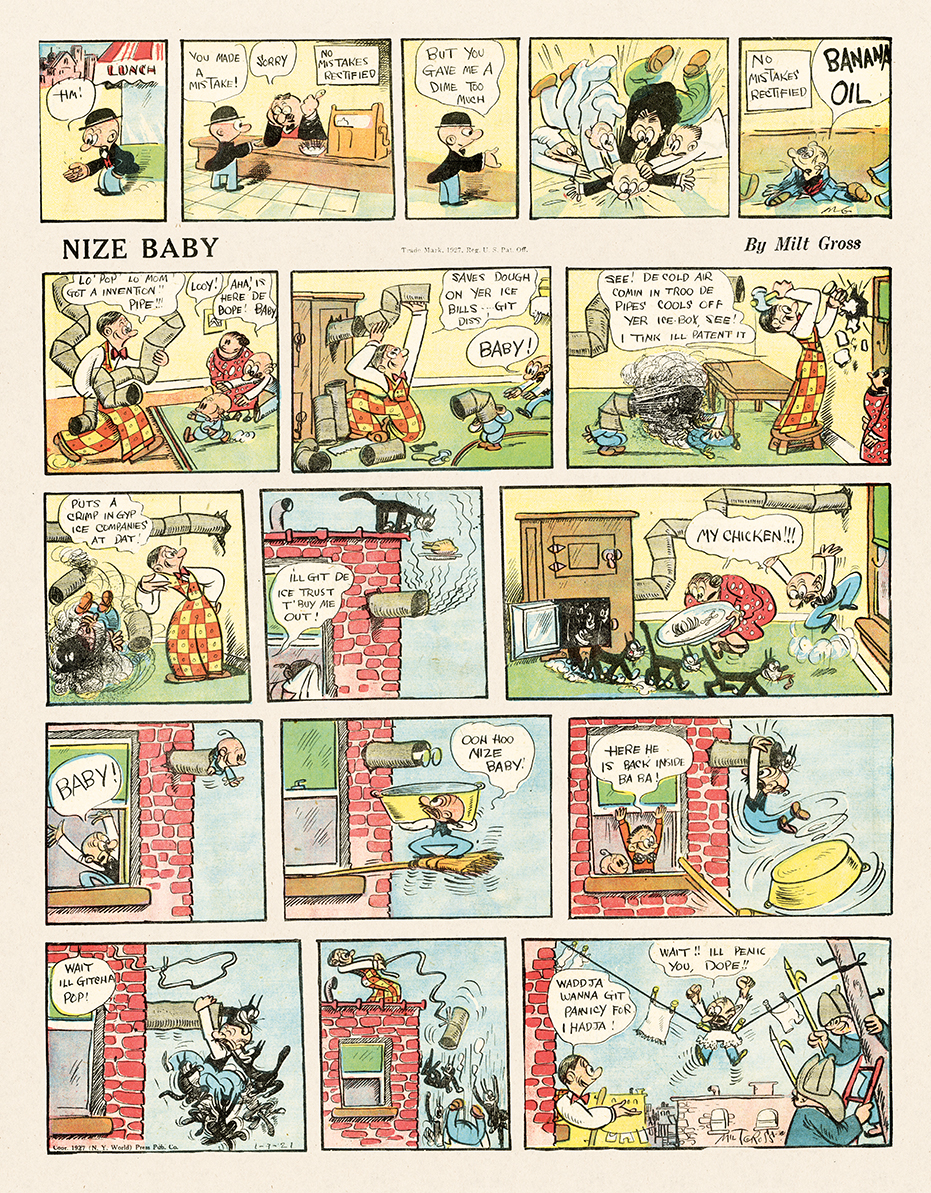
I am not a comics historian, scholar, or even fanboy fanatic. Like most kids in baby boom America, I consumed my share of comic books and Sunday newspaper strips (we got the Times for news and The Daily News for funnies — against my father’s better judgement). Full disclosure I was more a magazine gag cartoon (VIP, Gahan Wilson, Kliban, et al) connoisseur (less to read, quicker to laugh). Yet this should not suggest a total lack of appreciation for the many great talents who wrote and drew — and made quite an entertainment industry out of — their popular comic strips and iconic comic characters (and I don’t mean superheroes, either, not that I’m knocking super powers, mind you).
To prove my bona fides, in 1977 I was one of the first if my gang to order the entire Hyperion Collection of Classic American Comic Strips (a goldmine of well-done rarities); I avidly poured over Maurice Horn’s seminal works of scholarship, The World Encyclopedia of Comics, The World Encyclopedia of Cartoons, and 100 Years of American Newspaper Comics; I collected the authority Rick Marschall’s legacy books, notably America's Great Comic Strip Artists: From the Yellow Kid to Peanuts; I had the privilege to correspond with founder-director of the San Francisco Academy of Comic Art’s Bill Blackbeard, whose The Smithsonian Collection of Newspaper Comics, is required reading for any serious or latent comics devotee, as well as the ne'er-do-well, poseur and gadfly.


However, out of all the amazing collectors, hoarders, scholars, archivists, and authorities of this indigenous American art and design narrative form, I am most in awe of Peter Maresca, the founder in 2005 and publisher of Sunday Press, purveyor of newspaper comic page reprints, including strips by Winsor McKay, Lionel Feininger, George Herriman, Gustav Verbeek, E.C. Segar, and more. This story is as much a tribute to his incredible preservation vision as it is a salute to his latest collection: Gross Exaggerations: The Meshuga Comic Strips of Milt Gross.
Maresca calls himself "an accidental publisher." The accident began when in 2004, with the approaching centennial of Winsor McCay's Little Nemo in Slumberland, he decided "the world needed to see these Sunday masterpieces — arguably as genius as any American artwork, says I — in the original format before they went the way of all cheap newsprint."
He prides himself on making bookshelf-bursting stand-up-big books (as large as 16 x 22 inches) based on the original sizes of the old broadsheet newspaper pages. There are quite a few such scaled-up volumes, but Maresca, as far as I can tell, was the first to do this with comic strips (as well as get the color just perfectly right).


His latest is a surprising array of strips by the artist behind “Nize Baby,” the wacky Yiddish-accented comic featuring the Feitlebaum family (Morris and Mama, Isidore, Mama’s brother, Looey dot dope, and her nize baby). Although Gross's parents were Russian-born Jews, he claims to never heard Yiddish until he was in the army. Yiddish was not a new dialect for comics (or cartoons in magazines like the first incarnation of Life), but Gross took it to comic extremes by creating “a tortured yet playful amalgam that begged and rewarded a running syllable-by-syllable deconstruction,” writes Mark Newgarten in the introductory essay. Gross's speech-play was among his chief virtues. In addition to pages of “Nize Baby” starting in 1926, included are the strips “Count Screwloose of Tooloose” from 1929, “Babbling Brooks,” about an inmate of Nuttycrest asylum who repeatedly escapes yet always returns to Iggy (a dog at the asylum, who wears a Naopoleon bicorne hat) after experiencing that the real world is even more nuts. In “Dave’s Delicatessen,” started in 1931 and void of accents (boo hooey), is “a slightly less nutty ‘straight’ humor comic, while others are sorry souls.” which, says Maresca, produced Gross’s longest Sunday strip (1931-1935).


What Maresca doesn’t include because its much smaller than a comic strip (and I am the proud owner of a first edition of) is Gross’s first, 1930, He Done Her Wrong: The Great American Novel (And Not a Word In It — No Music, Too) novel, told through a stash of tawdry, dryly satiric bawdy and hilariously slapstick (did I mention bawdy, tawdry, and dryly?) vignettes about a love affair between a boy and a singer that is foiled by a disagreeable, womanizing villain, who gets his ultimate comeuppance (I won’t reveal anymore, since you all gotta see it for yourselves). Also there are, claims to the contrary not with-standing, a few choice words in it, which is a good way to end this here story . . . from the Foreword: “They laughed when I sat down to draw a novel, but they didn’t laugh when I fin . . . Oops! That didn’t sound so good. Well, anyway, once upon a time . . .”


